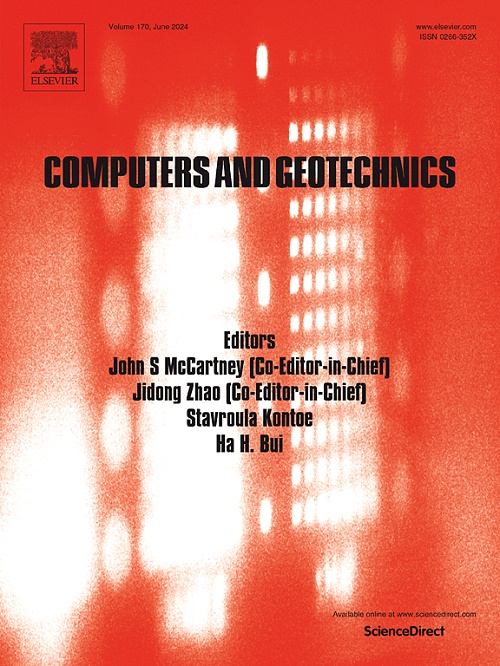层状页岩水力压裂界面裂缝扩展的动力学模拟与分析
IF 5.3
1区 工程技术
Q1 COMPUTER SCIENCE, INTERDISCIPLINARY APPLICATIONS
引用次数: 0
摘要
层状页岩层理界面处水力裂缝会产生渗透、导流、偏移等现象,对页岩气开采产量产生重大影响。如何模拟水力压裂在遇到界面时产生的不确定裂缝扩展路径是一个长期的挑战。在本研究中,提出了一种替代的周动力模型来研究层状页岩水力压裂的界面裂缝扩展。水压加载过程是通过将裂隙面上的水压等效转化为断裂键上的水压密度来描述的。采用双线性内聚带模型推导界面模型及其开裂判据,有效表征了顺层面不同侧面不同性质岩石之间的相互作用。通过与实验结果的对比,验证了该模型的有效性,并进一步应用于层理界面附近复杂水力裂缝的扩展研究。研究发现,层状页岩水力压裂方向与层理夹角越小,压裂效果越好,瓦斯提取率越高。本文章由计算机程序翻译,如有差异,请以英文原文为准。
Peridynamic modeling and analysis of interfacial crack propagation by hydraulic fracturing in layered shale
Hydraulic fractures at the bedding interface in layered shale will give rise to various phenomena including penetration, diversion and offset which significantly influence the production of shale gas exploitation. It is persistent challenge to simulate the uncertain fracture propagation paths induced by hydraulic fracturing when encountering interfaces. In this study, an alternative peridynamic model is proposed to investigate the interfacial crack propagation by hydraulic fracturing in layered shale. The water pressure loading process is described through equivalently transforming the water pressure applied on fracture surfaces into the water pressure density on broken bonds. The interface model and its cracking criterion are derived by employing bilinear cohesive zone model, which effectively characterize the interactions between rocks with different properties on different sides of the bedding plane. The proposed model is validated through comparison with experimental results, and then is further employed to investigate the complex hydraulic fracture propagation near bedding interfaces. It is found that smaller angle between hydraulic fracturing direction and bedding may lead to better fracturing effects and higher gas extraction in layered shale.
求助全文
通过发布文献求助,成功后即可免费获取论文全文。
去求助
来源期刊

Computers and Geotechnics
地学-地球科学综合
CiteScore
9.10
自引率
15.10%
发文量
438
审稿时长
45 days
期刊介绍:
The use of computers is firmly established in geotechnical engineering and continues to grow rapidly in both engineering practice and academe. The development of advanced numerical techniques and constitutive modeling, in conjunction with rapid developments in computer hardware, enables problems to be tackled that were unthinkable even a few years ago. Computers and Geotechnics provides an up-to-date reference for engineers and researchers engaged in computer aided analysis and research in geotechnical engineering. The journal is intended for an expeditious dissemination of advanced computer applications across a broad range of geotechnical topics. Contributions on advances in numerical algorithms, computer implementation of new constitutive models and probabilistic methods are especially encouraged.
 求助内容:
求助内容: 应助结果提醒方式:
应助结果提醒方式:


